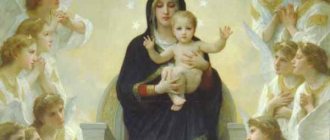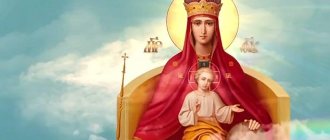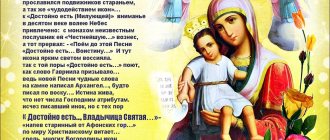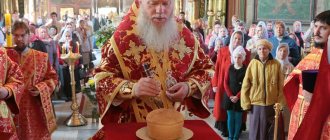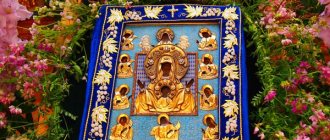It is impossible to count all the prayers. Some of them are composed by believers themselves when they need to turn to a saint, and well-known texts do not fully reflect the essence of the problem or are not suitable for a particular situation. A special group includes texts in the compilation of which Divine powers took part. Thus, in the prayer “It is worthy to eat,” some of the words brought to earth by the messenger of the Lord were added. The history of the ancient text is unusual. It emphasizes the importance of the Mother of God and strengthens the memory of her in the hearts of people.
The prayer “It is worthy to eat” as a song of praise to the Mother of God
“It is worthy to eat” is the most famous Orthodox chant of praise in honor of the Mother of God. The text of this prayer consists of two parts. The author of the words of the second part (“The Most Honest Cherub”) is considered to be Kosma Mayumsky. He was a Byzantine ecclesiastical poet who lived in the 7th and 8th centuries. But in the 10th century, the magnification “It is worthy to eat” was added to the Athonite Karey Lavra. Church Tradition says that it was announced by the Archangel Gabriel. For this reason, the prayer “It is worthy to eat” is called the “Archangel Song.”
The Orthodox prayer to the Mother of God “It is worthy to eat” is widely used not only during divine services, but also as an independent prayer. It is read or sung at the completion of any task, as thanksgiving after a meal, in evening prayers.
Icon of the Mother of God “It is Worthy to Eat”
The history of prayers
One of the most famous church Byzantine poets, Cosmas Mayumsky, was the author of a chant in honor of the Mother of God, which began with the words “Most honorable Cherub...”. This hymn has been sung before the holy image of the Virgin Mary since the 8th century.
100 years later, on June 11, 980, an event occurred after which the content of the prayer chant changed. A young Athonite novice served a prayer service before the image of the “Merciful One” for the prosperous journey of his spiritual mentor, who went to the all-night service in Kareia (the capital of St. Athos).
At this time, someone knocked on the door several times. A stranger in monastic robes stood on the threshold. He joined the novice’s prayer service, but when the time came to perform a chant in honor of the Mother of God, he stopped the monk with the words that it should have a different content.
The prayer of the unknown monk began with the words “It is worthy to eat...”. The novice asked to preserve the text, but there was no paper or ink in the cell. The monk took a piece of stone and wrote the contents of the prayer on it, like on a wax plate. At the same time, he said that all Christian believers should know these words. Having finished writing, the monk called himself Gabriel and disappeared from his cell.
When the elder returned from the all-night vigil the next morning, the novice told him about the miracle that happened that night. The spiritual father realized who the night guest was. The stone slab with the words of the solemn chant was sent to Constantinople. By the decision of the Patriarch of Constantinople Nicholas II Chrysovergo, the Archangel prayer became part of the Orthodox worship.
The holy image, in front of which the chant “It is worthy to eat...” was first performed, was transferred to the Assumption Church in Kareya and began to be named after the name of the prayer chant.
Icon of the Mother of God “It is Worthy to Eat”
During the time of Constantine the Great in 335, the first Assumption Church was built on Mount Athos. Since the 10th century, on the high place of the altar there has been a revered image of the Mother of God “It is Worthy to Eat.” The name of the icon is associated with the church hymn of the same name.
In one cave, an old man and a novice labored. According to legend, on June 11, 982, the elder monk went to serve in the temple, and the novice remained in his cell. At night a stranger came who called himself Gabriel. The novice invited him to rest from the road. Together they stood up for prayer and chanted psalms. When the novice began to sing the words “Most Honest Cherub” to the Mother of God, the stranger said that in his places before these words it is sung first “It is worthy that You are truly blessed, the Mother of God, the Ever-Blessed and Most Immaculate, and the Mother of our God.”
At this time, the icon of the Most Holy Theotokos, called the “Merciful One,” began to shine with light. At the novice’s request to write down the words of the miraculous chant, Gabriel, due to the lack of paper and ink, began to write with his finger on a stone slab, which became soft as wax. After that the guest disappeared. The elder who returned from the service, after listening to the story of his novice, realized that the Archangel Gabriel himself had visited the cell. From that time on, the image of the Most Holy Theotokos began to be called the same as the prayer - “It is worthy to eat.”
According to tradition, every year on the Monday after Easter, Athonite monks perform a procession with the miraculous icon of the Mother of God “It is Worthy to Eat” around the Kutlumush Monastery.
One day Elder Paisiy Svyatogorets (1924-1994) witnessed a wonderful fragrance:
“On Monday of Bright Week, I sat in the archondarik of my cell and said the Jesus Prayer. Suddenly I felt an unusually strong fragrance, went out into the corridor to see where it was coming from, then went to the church - but the fragrance was not coming from there. I walked out of the kaliva into the yard. Here the fragrance was felt stronger. Then I heard someone hitting a wooden beater. Looking towards the Kutlumush Monastery, I saw the procession of the Cross going down, and I realized that this fragrance was coming from the icon of the Most Holy Theotokos.”
The image of the Virgin Mary “It is worthy to eat” is honored on June 24 according to the new style.
The Meaning and Power of Prayer
The prayer book, which was dedicated to the Mother of God, is closely connected with the icon on which she is depicted. This icon was found back in 980, but this creation gained wide popularity in 1864. At that time, the image was located in the Athos monastery, next to which lived a sage with his assistant. One night he was just holding a service in the monastery when a stranger knocked on the door of the house. An assistant let him in. The guest introduced himself as Gabriel, and he was invited to stay for night prayer.
The service went on as usual, and no one noticed anything special. However, when the moment came to worship the Mother of God, the stranger invited the monk to read a new prayer book. He did not find where to write down the words of the prayer, so Gabriel touched the stone, and it immediately turned into a sheet of paper. From that moment on, the new sacred text began to be considered a creation, which was recorded from the words of the saint himself.
This prayer was originally written in Greek. However, over time it was translated, so even now it is actively used by Orthodox Christians. In order for this text to help you, you need to appear before the image of the Mother of God and then read a prayer for one of the following purposes:
- so that success follows you in all your endeavors;
- to wait for marriage as soon as possible;
- so that family life turns out to be happy;
- so that the couple finally has a child.
Many Orthodox Christians turn to the Mother of God with the words of this prayer if they suffer from illnesses or injuries. It is believed that if you say this prayer with all sincerity, even mortal sins will be forgiven in Heaven.
As for the icon itself, it depicts the Mother of God holding a baby in her arms. This image is believed to have healing properties, which is why many Christians kneel before it.
What is remarkable about this prayer book is that with its help you can turn to the Mother of God and ask her for help in any matter, family, female and maternal happiness, as well as healing from various diseases. But what is most important is that if an Orthodox Christian appears before the icon, says the prayer “It is worthy to eat,” and at the same time sincerely repents, then even mortal sins will be forgiven him.
There are actually very few such religious texts in Orthodox theology, which is why it is considered popular.
Lists of the icon of the Mother of God “It is Worthy to Eat”
Widespread veneration of the “It Is Worthy” icon in Russia began in the mid-19th century.
In 1853, the rector of the Russian St. Panteleimon Monastery, Archimandrite Gerasim, donated a list (copy) of an icon that was little known in Russia at that time to the Arzamas Alekseevsky Convent (Nizhny Novgorod region). With the advent of Soviet power, the monastery was closed, many shrines were desecrated, including the image of the Mother of God “It is Worthy to Eat.”
In 1997, in Arzamas, in the outbuilding of an old house, the surviving central part of the icon of the Mother of God was found. However, the face of the Most Holy Theotokos was severely mutilated by the axe. The found image was transferred to the St. Nicholas Convent. After the procession of the cross, this icon underwent a miraculous renewal. The next day the image began to stream myrrh. After some time, new paint began to appear in place of the eyes of the Mother of God, which were cut out during the desecration, as if an invisible icon painter was painting them. Now the icon “It is Worthy to Eat”, located in Arzamas, is known as “Chopped”. From her, believers receive healing from their illnesses, especially headaches and eye diseases.
In 1887, Hieromonk Arseny brought a copy of the “It Is Worthy to Eat” icon from Mount Athos to St. Petersburg. Especially for this image, a five-domed temple in the Byzantine style was built in Galernaya Harbor. In 1950, the image, revered among believers, was moved to the Smolensk Church, where the northern aisle was consecrated in its honor.
In the Zadonsk St. Tikhon's Transfiguration Convent (Lipetsk region) there is a particularly revered copy of the “It Is Worthy to Eat” icon. An image of the Athos letter, about which there is a corresponding entry in Church Slavonic. At the end of the 20th century, the colors on the icon faded, and spots were visible in places. On November 26, 2000, the image of the Mother of God was renewed. The miracle happened just during the period of restoration work in the Assumption Church.
Icon of the Mother of God “It is worthy to eat”: what helps
The image of the Most Holy Theotokos “It is Worthy to Eat” is especially revered in the Orthodox world. The Mother of God, as a Merciful Intercessor, helps those asking for Her help in front of this icon with various everyday difficulties. It is believed that turning to the icon helps to cope with epidemics of various diseases. Also, before the miraculous image, they pray for blessings on marriage.
“Let us give Her with one mouth and one heart our pure childish praise. Small children always cling to their mother and hold on to her. And you, spiritual children of your Heavenly Mother, place your hopes in Her in all your sorrows and difficulties and remember that She tirelessly prays for the Christian race” (St. Luke of Crimea, 1877-1961).
@Κύριεἐλέησον.με
Book 15. Lesson 38
I. _ On the day of the glorification of the Mother of God, the most honorable cherub and the most glorious seraphim without comparison, as is sung in a well-known church song, it would be appropriate, brethren, to talk with you about the origin of this sacred song. How often do we hear this sacred song in honor of the Most Holy Theotokos: it is sung daily during divine services. But not only we sinners glorify the Mother of God, She is glorified by the celestials, the angels and all the heavenly armies, because She is more honorable than the cherubim; and it is remarkable that the same song with which we glorify the Mother of God is sung by the angels of God in heaven.
In one cell on St. Mount Athos, one elder of the monastics labored with his novice. One day he wished to attend the all-night vigil on Sunday in the cathedral and went there, but his disciple remained at home. Night has come, and now the young man hears a knock on the door. He opens it and sees an unfamiliar wanderer-monk. He takes him into his cell and leaves him for the night. Meanwhile, the time had come for the service of God, and both of them, the host and the guest, reverently began to praise the Lord in the silence of the night. Their all-night service went on quietly in its own order; the time has come to magnify the Most Holy Virgin Mother of God and glorify the most honorable cherub and the most glorious without comparison seraphim, and so they stood before her icon and began to sing... The monk owner, full of heartfelt tenderness and reverence for the All-Sung, touchingly sang: The most honorable cherub and the most glorious without comparison seraphim, without the corruption of God the Word, Who gave birth to the living Mother of God, we magnify Thee. But the wondrous guest began in a sweet angelic voice: It is worthy to truly bless You, the Mother of God, the Ever-Blessed and Most Immaculate, and the Mother of our God, - and to this he already added the Most Honest to the end.
- Wonderful! - the monk exclaimed to tears, moved to tears by the new song, - but we sing only the Most Honest... And such a song Worthy to Eat has never been heard before, not only by us, but also by our ancestors. However, I beg you: write me this song, so that I, like you, can magnify and glorify the Mother of God.
“Okay,” said the stranger, “give me paper and ink, I’ll write you this song for memory.”
“Forgive me, brother,” the monk answered his guest with regret, “being engaged in prayer and handicrafts, we rarely need them, and therefore now there is neither one nor the other.”
“Then bring me at least some stone slab,” said the guest.
The monk's owner immediately brought and handed him a slab, and with his finger he began to write on it the entire mentioned song, and - lo and behold! The stone softened like wax under the hand of the elder visitor: his writing finger cut deeply into the stone, and the words were clearly and clearly imprinted on the slab. Having finished the scripture, the mysterious guest handed the owner a stone and said: “From now on, sing like this forever, both you and all Orthodox Christians,” he said and, like lightning, suddenly disappeared... It was the Archangel Gabriel, sent from God to announce to the Christians the song composed by the angels in honor Mother of God. Joy and trepidation overwhelmed the humble young monk; For a long time, amazed by the miracle, he stood with reverence before the words inscribed by the hand of the archangel and, not trusting himself, felt them with his hands, reread them and memorized them. At dawn the elder returned and found his disciple singing a new song.
- Where did you learn to sing like that? - he asked the student, surprised by his singing.
The student told him everything that had happened, pointed to the very board with a wonderful song written on it: It is worthy to eat... The old man looked in amazement at this stone slab covered with writing by an unearthly hand, reread the sacred song many times and finally, taking the stone, presented it for consideration. a whole council of elders and told all the details of this event. Then everyone glorified the Lord and sang a new song to His Most Pure Mother. The holy icon, before which the archangel sang this song, began to be called Worthy to Eat; this icon is still located on Mount Athos.
II . a) Oh, it is truly worthy to magnify the Mother of God!
The Most Holy Virgin Mary, being like all mortals, became the Matter of God, conceived without seed, carried in her womb and gave birth to God, the Creator and Almighty.
She, upon Her Dormition, ascended to heaven and, like the Mother of God, ascended above all the powers of heaven, becoming the Lady and Mistress of the world; She is glorified, She is worshiped by archangels and angels, cherubim and seraphim.
All creation, visible and invisible, obeys Her. How can we, Christians, not please even the Most Holy Virgin Mary every hour, when the Lord Himself deigned to dwell in Her womb, and as a result, who is now closer to Her to the Son of God in order to intercede before Him for us sinners?
Who, finally, loves us more than Her? The miracles of Her mercies are innumerable. To how many of Her icons did She impart miraculous power! And what is it all for? In order to make it all the more convenient for us to use the currents of Her generosity and goodness. Truly, for the Christian world She is a light-fruitful tree, from which vernias, a blessed-leaved tree, are nourished, and many are covered with it.
b) We must constantly call upon the Mother of God, the heavenly Queen and Lady of the world, to resort to Her in all troubles and misfortunes, to place all our hope and hope in Her, and to expect mercy, intercession and salvation from Her; for She was given from Her Son and our God the grace to save and cover the Christian race; She, according to St. The Church, a representative of Christians, a refuge for the faithful, an insurmountable wall. She is a helper to all the offended, hope to the hopeless, intercessor to the poor, consolation to the sad, nurse to the hungry, clothing to the naked, healing to the sick, salvation to the faithful (prayer to the Mother of God). When resorting to this great Intercessor, we must cry out from the depths of our souls: Help the Lady, who has had mercy on us! Most Holy Theotokos, save us!
c) But in order for our chants and prayers to be pleasing to the Blessed Virgin Mary, we must remove ourselves from sins. Otherwise, our hymns and prayers will not only not be pleasing to the Most Pure Mother of God, but will even be offensive to Her. This is what St. says about this. Demetrius of Rostov: “Listen to me, all sinners, from them I am the first! I turn to you and to myself: we repeat the Archangel’s greeting to the Blessed Virgin - “Rejoice”, we read akathists, we fall before our Lady, we pray to Her, but we do not abstain from our sins, we do not care about true repentance. What do we think - will our prayer, singing and worship of the Blessed Virgin Mary please? If someone snatched his beloved child from his mother’s hands, threw him on the ground and began to trample him underfoot, then in front of her eyes he would stab him in the heart with a knife, and then come up to her and, bowing, begin to say: Hail, hello, be You are merciful to me: would that mother have liked these bows and greetings from the murderer? Judge for yourself.
And we, unrepentant sinners, every time we sin, we take the Lord Jesus Christ away from the hands of His Immaculate Mother; we cast down, trample and gore, crucifying Him on the cross again!.. And the Mother of God looks at all this, and we, the crucifiers of Her Son, fall to Her and say: Rejoice! Be merciful to us!.. Won't we anger Her even more? Are we not renewing Her heart disease, which She suffered at the cross of Her Son and our God?
III . Let us now be diligent towards the Mother of God, the father of sin and humility, and let us fall in repentance calling from the depths of our souls: Lady, help us, having had mercy on us, struggling, we are perishing from many sins, do not turn away Your servants of vain, For You are the only hope of the Imams.
Wonderful help from the icon “It is Worthy to Eat”
In the summer of 1990, due to extreme heat on Mount Athos, several monasteries were engulfed in fire. After the prayer service in front of the icon of the Mother of God “It is Worthy to Eat,” the fire went out on its own.
In the late 90s, a resident of the Samara region, Svetlana, began drinking heavily after the death of her husband. Relatives repeatedly tried to treat her, but medical means and methods did not help. Friends advised Svetlana to visit the Church of the Intercession in the village of Belovka (Samara Region), which she eventually arrived in 2007. The woman prayed to the Most Holy Theotokos in front of the icon “It is worthy to eat.” When she kissed the image, she felt a slight warm shock, like an electric shock. After this, Svetlana developed an aversion to alcohol.
Prayer before the icon of the Mother of God “It is worthy to eat”
Oh, most holy and most merciful Lady Theotokos! Falling before Your holy icon, we humbly pray to You: listen to the voice of our prayer, see our sorrow, see our misfortunes and, like a loving Mother, trying to help us helpless, beg Your Son and our God, that He may not destroy us for our iniquities, but show We are kind to His mercy.
Ask us, Lady, from His goodness for bodily health and spiritual salvation, and a peaceful life, fruitfulness of the earth, goodness of the air, and a blessing from above for all our good deeds and undertakings, for our Orthodox army for victory and victory over all enemies. And just as in ancient times You mercifully looked upon the humble praise of the Athonite novice, who sang Thee before Thy most pure icon, and You sent an Angel to him to teach him to sing the heavenly song with which the Angels praise Thee, so now accept our fervent prayer offered to You. About the all-singing Queen! Extend your God-bearing hands to the Lord, in the image of the Infant Jesus Christ you bore, and beg Him to deliver us from all evil.
Show, O Lady, Your mercy to us: heal the sick, comfort the sorrowful, help the needy, and grant us the honor to complete this earthly life in a pious manner, to receive a Christian shameless death and to inherit the Heavenly Kingdom through Your Mother’s intercession to Christ our God, born of You, who is with His Beginning Father. and to the Most Holy Spirit is due all glory, honor and worship, now and ever, and unto ages of ages. Amen.
